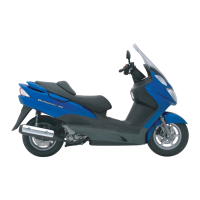2-18 PERIODIC MAINTENANCE
AIR BLEEDING FOR THE FRONT BRAKE FLUID CIRCUIT
Air trapped in the fluid circuit acts like a cushion to absorb a
large proportion of the pressure developed by the master cylin-
der and thus interferes with the full braking performance of the
brake caliper. The presence of air is indicated by “sponginess”
of the brake lever and also by lack of braking force. Considering
the danger to which such trapped air exposes the machine and
rider, it is essential that, after remounting the brake and restor-
ing the brake system to the normal condition, the brake fluid cir-
cuit be purged of air in the following manner:
• Fill up the master cylinder reservoir to the “UPPER” line.
Place the reservoir cap to prevent entry of dirt.
!
• Connect a clear hose to the air bleeder valve, and insert the
free end of the pipe into a receptacle.
• Squeeze and release the brake lever several times in rapid
succession and squeeze the lever fully without releasing it.
Loosen the bleeder valve by turning it a quarter of a turn so
that the brake fluid runs into the receptacle; this will remove
the tension of the brake lever causing it to touch the handle-
bar grip. Then, close the valve, pump and squeeze the lever,
and open the valve.
• Repeat above procedures until the fluid flowing into the recep-
tacle no longer contains air bubbles.
NOTE:
Replenish the brake fluid in the reservoir as necessary while
bleeding the brake system. Make sure that there is always some
fluid visible in the reservoir.
• Close the bleeder valve, and disconnect the clear hose.
# Air bleeder valve: 6 N·m (0.6 kgf-m)
• Fill the reservoir with brake fluid to the “UPPER” line.
Handle brake fluid with care: the fluid reacts chemi-
cally with paint, plastics, rubber materials and so on.

